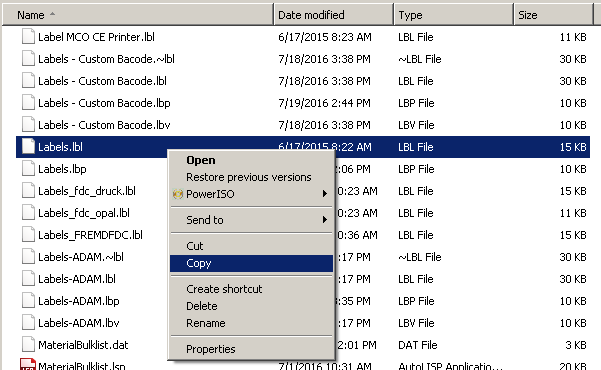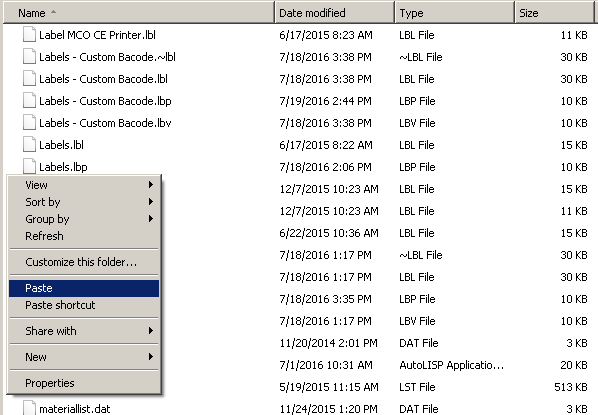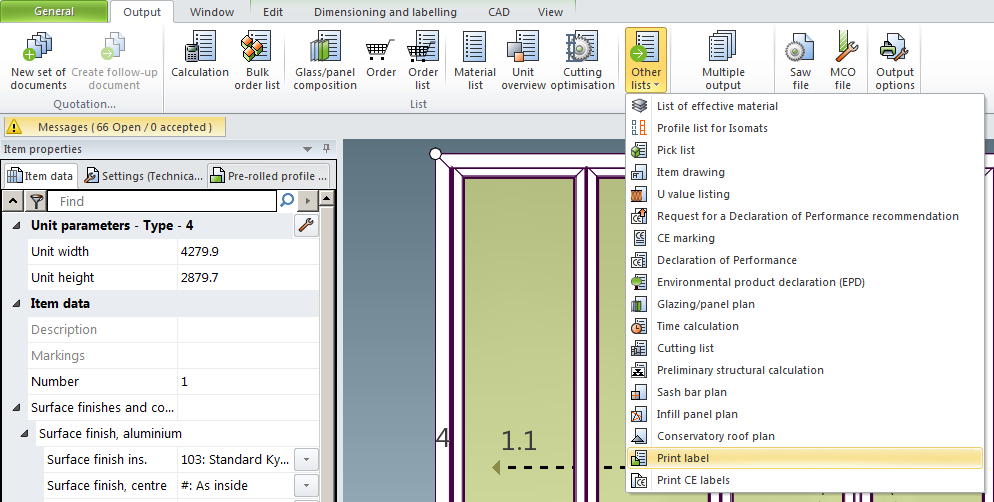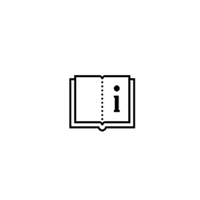How do we control what code of the barcode is used on the labels? How to change between Code 128a, Code 39, EAN 13 and Code 93?
User has access to SchuCal List & Label Designer where it is possible to add, delete or modify the labels as well as rearrange its positions. To modify the template we must create copy of Barcode Label template first. Go to :
C:\ProgramData\Schueco\SchueCal\System\Data\Templates
and find file Labels.lbl. Create the copy of it:


You can leave the name as default (Labels – Copy.lbl) it or change it to more specific for your new label type.

Now, the open project and go to Output > Other list > Print label:

Focus in Default field and type your newly created template file name, then click Edit template button:

Double click barcode area in the template editor (Red mark):

Right to the formula click button Edit:

Now in formula edit area delete second parameter of Barcode function “25INT”: (do not remove closing parenthesis)

After deleting it, formula editor will suggest you all other possible parameters for this function. Slide down and select desired on, e.x. EAN 13:

Final syntax of the formula:

Close Edit Formula window with button OK.
Close Barcode Content window with OK.
Close Template Editor with saving changes.
Confirm Output window with OK.
Now you should receive printout with new barcode type EAN 13:

ANNEX
Below you can find overview of major 1D codes and its descriptions:
| Name | Formats and permitted characters |
| GTIN-13, EAN-13, UCC-13, JAN-13 | Formats: cc|nnnnn|aaaaa (normal EAN13) cc|nnnnn|aaaaa|xx (EAN13 for newspapers, “ISSN”) cc|nnnnn|aaaaa|xxxxx (EAN13 for books, “Bookland”) ppp|nnnn|aaaaa (normal EAN13) ppp|nnnn|aaaaa|xx (EAN13 for newspapers, “ISSN”) ppp|nnnn|aaaaa|xxxxx (EAN13 for books, “Bookland”) cc = country code ppp = product code nnnn, nnnnn = country code aaaaa = article code | = character code chr(124) xx, xxxxx = supplemental code Permitted characters: [0-9] The check digit will be calculated and attached automatically. Each character is 7 bar-widths wide, a code should have a minimum width of (12*7+11)*0.3 mm = 2.85 cm.Ideal size (bar symbol) nominal size SC2: Width: 31.4 mm, Height: 24.5 mm Minimum offset that should be kept free around the symbol: left: 3.6 mm, top: 0.3 mm, right: 2.3 mm, bottom: 0.0 mm The text may partially exceed this area. |
| EAN-14, UCC-14 | Format: nnnnnnnnnnnnnn (14 digits) Permitted characters: [0-9] |
| GTIN-8, EAN-8, UCC-8, JAN-8 | Formats: nnnnnnn, nn|nnnnn (|= character code chr(124)) Permitted characters: [0-9] Each character is also 7 bar widths wide, a code should then have a minimum width of (8*7+11)*0.3 mm=2.01 cm. Ideal size (bar symbol) nominal size SC2: dx : 22.1 mm, dy: 19.9 mm Minimum offset that should be kept free around the symbol: left: 2.3mm, top: 0.3mm, right: 2.3mm, bottom: 0.0mm (if printed, otherwise 0.3 mm) The text may partially exceed this area. |
| UPC-A | Format: c|nnnnn|aaaaa, cnnnnnaaaaa c = number system nnnnn = company code aaaaa = article code | = character code chr(124) Permitted characters: [0-9] The check digit will be calculated and attached automatically. Each character is also 7 bar widths wide, a code should then have a minimum width of (13*7+6)*0.3 mm=2.88 cm. |
| UPC-E | Format: c|nnnnnn, nnnnnnn c = number system |= character code chr(124) nnnnn = code, interpretation depends on the last position Permitted characters: [0-9] The check digit will be calculated and attached automatically. Each character is also 7 bar widths wide, a code should then have a minimum width of (13*7+6)*0.3 mm=2.88 cm |
| 2-of-5 Industrial | Format: any Permitted characters: [0-9] A code is (14*number of characters+18) bar widths wide. |
| 2-of-5 Interleaved (ITF) | Format: any, must have an even number of characters Permitted characters: [0-9] A code is (9*number of characters+9) bar widths wide. |
| 2-of-5 Matrix | Format: any Permitted characters: [0-9] A code is (10*number of characters+18) bar widths wide. |
| 2-of-5 Datalogic | Format: any Permitted characters: [0-9] A code is (10*number of characters+11) bar widths wide. |
| Codabar | Format: fnnnnnf Permitted characters: f = frame code [A-D], n = [0-9], [-$:/.+] Every character is either 2*3+6*1 (characters ‘0’..’9′, ‘-‘, ‘$’) or 3*3+5*1 (characters ‘:’, ‘/’, ‘.’, ‘+’, ‘A’..’D’) bar widths wide. The characters for the frame code will not be printed with the text |
| CODE11 | Format: any Permitted characters: [0-9],[-] Code 11 has, depending on the length, 1 or 2 check digits. It calculates only 1 instead of 2 check digits if the length of the text is a maximum of 10 characters. |
| Code39, 3-of-9, Alpha39 | Format: any Permitted characters: [A-Z], [0-9], [-./$%+*] |
| Extended code 39 | Format: any Permitted characters: any The expanded code can be activated by a combination of the standard code: for example: ‘+A’ -> ‘a’. Every character is 16 bar widths wide, a text has (16*number of characters –1) bars. |
| Code 39 with CRC | Format: any Permitted characters: [A-Z], [0-9], [-./$%+*] |
| Code 93 (simple and extended) | Code 93 is an extension of Code 39 and covers the complete 128 bytes of the ASCII Allowed characters, including NULL. This must be transferred as chr$(255). It contains two check digits that are automatically generated. The characters consist of 9 bar widths, that each have 3 bars and 3 spaces. There are two options for the extended code: a) transfer of the shift character from the host program as$ chr$(254) % chr$(253) / chr$(252) + chr$(251) b) transfer of the desired character, L&L adds the appropriate shift character. |
| Code128 | Format: any Permitted characters: any Determine the code set that should be used. Use one of the following codes as a start character: chr$(135) – start with code A chr$(136) – start with code B chr$(137) – start with code C In order to switch between different code sets within the barcode, you can use the usual control characters: Starting from code A to B: chr$(132) C: chr$(131) Starting from code B to A: chr$(133) C: chr$(131) Starting from code C A: chr$(133) B: chr$(132) Example: <Subset B> “RL” <Subset C> “04432476” <Subset B> “0DE110″ Barcode(Chr$(136)+”RL”+chr$(131)+”04432476″+chr$(132)+”0DE110”, “Code 128”) |
| Code128-Full | Unlike the “normal” Code128, this code allows the use of the entire Latin-1 character set. Special characters must be replaced as follows: NUL: chr$ (256) FNC1: chr$ (102+32) FNC2: chr$ (97+32) FNC3: chr$ (96+32) |
| EAN128-Full | Unlike the “normal” EAN128, this code allows the use of the entire Latin-1 character set. The special character FNC1 after the start character unambiguously defines the EAN128. Special characters must be replaced as follows: NUL: chr$ (256) FNC1: chr$ (102+32) FNC2: chr$ (97+32) FNC3: chr$ (96+32) |
| GS1 128, EAN128 | The special FNC1 character following the start character uniquely defines the EAN128 code. Special characters must be replaced as follows: NUL: chr$ (255) FNC1: chr$ (254) FNC2: chr$ (253) FNC3: chr$ (252) FNC4: chr$ (251) |
| GS1 DataBar (Limited, Stacked, Stacked Omnidirectional, Stacked Truncated) | Format: nnnnnnnnnnnnn (13 digits) Permitted characters: [0-9] |
| GS1 DataBar Expanded) | Format: Data begins with AI. Max. 74 numeric/41 alphanumeric characters Permitted characters: any |
| IM (4CB/4-CB/USPS4CB) | Intelligent Mail Barcode (US Postal Services). Alternative name: One Code Solution or 4-State Customer Barcode). Format: 20, 25, 29 or 31 digits Permitted characters: [0-9] |
| ISBN | Format: nnn|nnnnnnnnnn (12-digit, no check digit) Permitted characters: [0-9] |
| MSI | Format: any Permitted characters: [0-9], [A-F] |
| Pharma-Zentral-Nummer | Format: nnnnnn (6 digits) Permitted characters: [0-9] |
| Pharma-Zentral-Nummer (neu) | Format: nnnnnnn (7 digits) Permitted characters: [0-9] |
| SSCC/NVE | Format: {nn}nnnnnnnnnnnnnnnnn (17 or 19 digits) Permitted characters: [0-9] |
Overview of major 2D codes:
| Name | Formats and permitted characters |
| Aztec | Format: any. Note the options dialog. Permitted characters: any |
| Datamatrix | In order to enter non-printable characters (binary data) in the barcode text, they must be packaged in a special string. The data is inserted using the ~dNNN string, whereby NNN stands for ASCII-Code. Example: DEA~d065~d015~d000~d247~d220 (~d065 stands for “A”) To represent an EAN data matrix, you can code the special FNC1 character as ~1. The Datamatrix symbology uses the ECC 200 error correction code. Further options like size, module format and encoding can be set in the barcode’s options dialog. Click the options symbol in the barcode content dialog to enter this dialog. |
| PDF417 | Can display all available and non-printable characters. Note the options dialog. In order to enter non-printable characters (binary data) in the barcode text, they must be packaged in a special string. The data is inserted using the “{binary:nn}” string, whereby nn stands for any sequence of two-character hexadecimal numbers. This is especially important if Maxicodes are to be created according to UPS specifications; the special characters needed for this can be entered in this way: In order to pack a Null and a Backspace (BS) character in the data, use “{binary:0008}” (corresponds to “{binary:00}{binary:08}”). Use “Hallo{binary:0d0a}World” to include a line break. |
| QR Code | Format: any. Note the options dialog. Permitted characters: all characters In order to enter non-printable characters (binary data) in the barcode text, they must be packaged in a special string. The data is inserted using the ~dNNN string, whereby NNN stands for ASCII-Code. Example: ~d065 stands for the letter “A”. |

